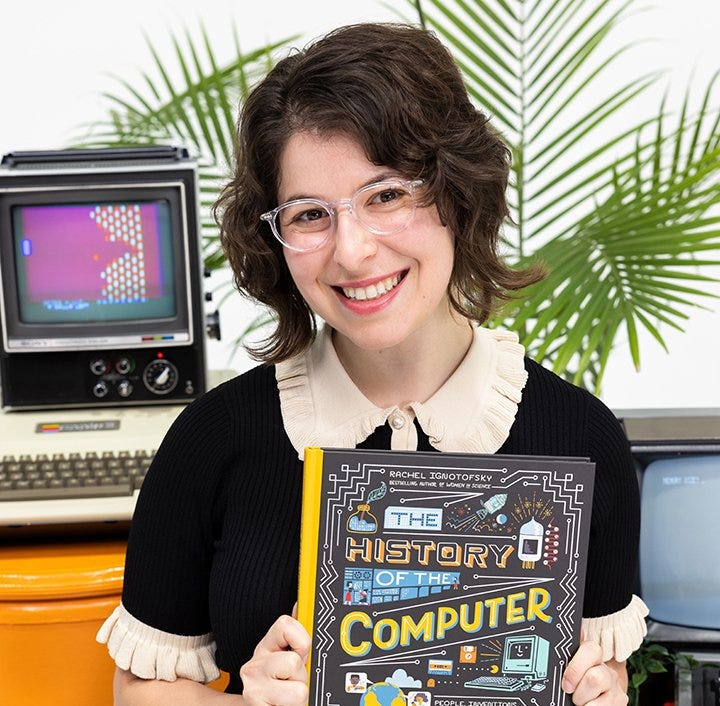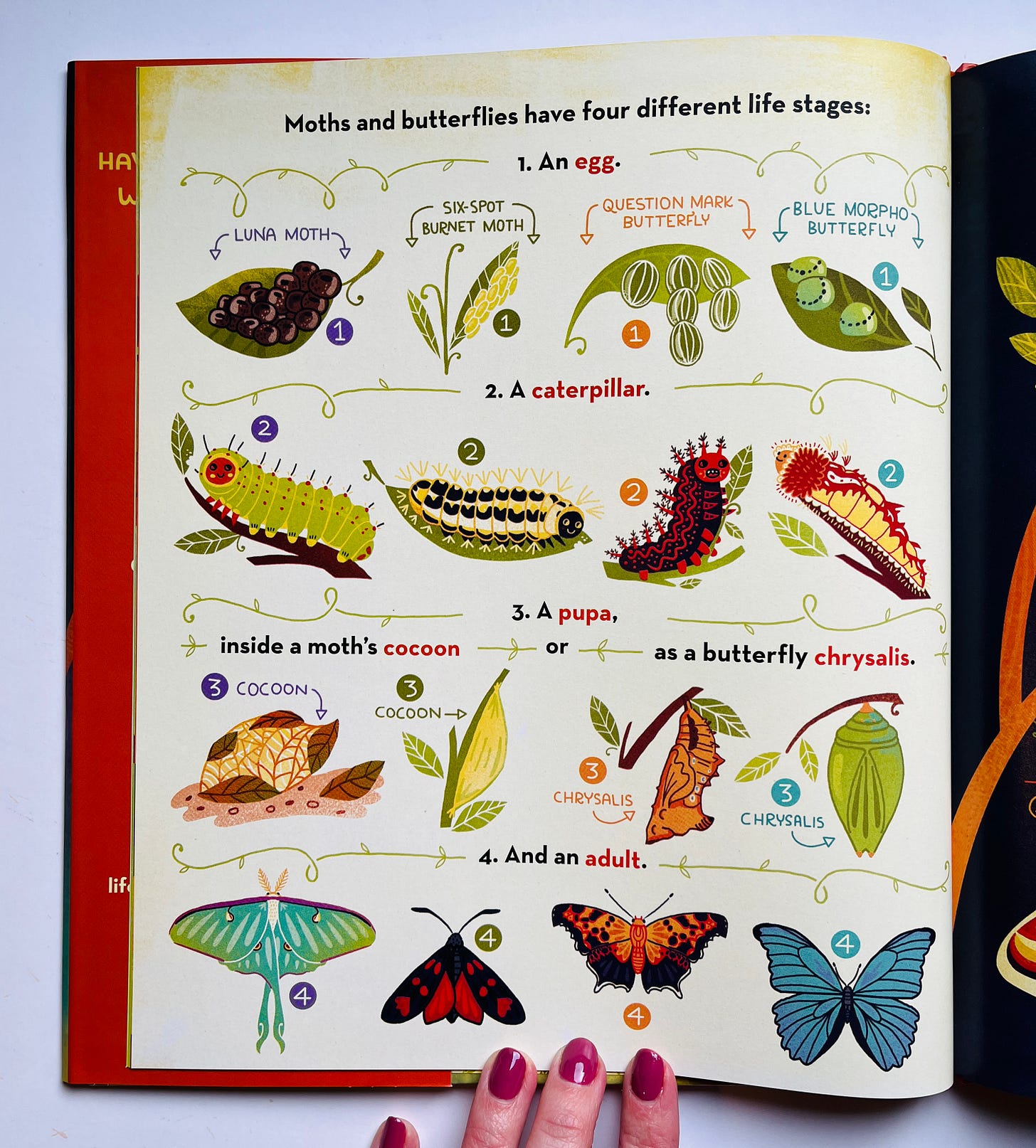Micro review: What’s Inside a Caterpillar Cocoon? + interview with Rachel Ignotofsky
Notes From the Reading Nook: October 10
Hi there! I have a fun micro review and little interview for you today, so I will spare you my normal introductory ramblings (thank you for being on the receiving end of my normal introductory ramblings) and just get right to it.
(Though, ICYMI, last week I sent out my huge special edition on Halloween.)
You’re fantastic and you look great today, btw.
This Land is Your Land by Woody Guthrie, illustrated by Kathy Jakobsen
Applebet: An ABC by Clyde Watson
Autumnblings by Douglas Florian
The Apple Cake by Nienke Van Hichtum
Pokko and the Drum by Matthew Forsythe
Micro review: What’s Inside a Caterpillar Cocoon? And Other Questions About Moths & Butterflies (2023)
First of all, I didn’t come to this book unbiased — I’ve been a fan of Rachel Ignotofsky’s since I first laid eyes on the amazing Women in Science: 50 Fearless Pioneers Who Changed the World when it was published in 2016, which not only reshaped the way I looked at single-page biography collections but also made me realize I knew a disturbingly small amount about women in science.
I’ve paid close attention to all her releases since then and was thrilled when Random House Children’s Books not only offered me the chance to review her latest in the What’s Inside… series, but also an interview with Ignotofsky herself.
The thing about her work is that it’s absolutely impeccable — she writes it all herself, and it’s always first-rate, super engaging, and informative, and she produces these deeply detailed, vibrant illustrations (traditionally and digitally) with her own specific style that’s easily recognizable once you’ve spent some time with them — and What’s Inside a Caterpillar Cocoon? And Other Questions About Moths & Butterflies is no exception.
It’s gorgeous, see?
And full of facts that draw you in…
(I cannot get over “Its old body becomes soup-like.” Literal LOL 😂)
I know plenty about moths and butterflies, but in addition to poring over the images in this book — which cover basically every inch of every page — I learned a few things I didn’t already know. (For instance: when a caterpillar molts, there’s a sticky silk pad that attaches the old skin to a leaf/other surface, so when it splits open, the caterpillar can molt its way out. And most caterpillars molt five times. WHAT?!)
This book ticks basically every box for me, and I highly recommend it for curious, nonfiction-loving preschoolers all the way up to late elementary-aged kiddos. (Plus moth and butterfly lovers, of course.)

An interview with Rachel Ignotofsky

What drew you (pun intended, ha!) to writing and illustrating nonfiction children's books?
When I was a kid, I really struggled with reading. Then I discovered heavily illustrated non-fiction books like Magic School Bus and DK books, and for the first time I was having fun reading. They really spoke to me as a young reader. As a professional artist I wanted to make the kinds of books I loved as a kid — heavily illustrated books, jammed packed with illustrations and infographics for the reader to explore.
Where do you get ideas for your books?
All my books are inspired by topics that I personally want to know more about, or that I know will be useful in the classroom. For my newest book, What’s Inside a Caterpillar Cocoon?, I was inspired by the nature in my own backyard. I happen to live right on the butterfly migration route in southern California, and it is also a biodiversity hotspot for all kinds of insects. Watching the caterpillars eat milkweed in my garden and transform from the chrysalis into butterflies in real time, all while working on this book about moths and butterflies, was special.
Kids often have questions about the natural world that seem small, but have big answers that are the basis of an elementary biology education. The other books in the series, What’s Inside a Flower? And the upcoming What’s Inside a Bird’s Nest? [March 2024] use that curiosity to celebrate science and springtime.
Do you have any regular, consistent sources of inspiration?
You must read books to make books. But it is also very important to go out and experience your nonfiction topic in the real world. I always set up adventures like visiting museums, historical sites, national parks, that are on topic. For example, while working on What’s Inside a Bird’s Nest?, I hiked several wildlife preserves and went bird watching to see bluebirds build their nests in the wild. Bluebirds are the stars of the book and it was awesome seeing the juveniles interact with their parents. I couldn’t have done the illustrations in my book without that kind of inspiration!
Can you recommend 3-5 titles for the readers of my newsletter? (Either ones you've loved yourself, or ones you want to introduce to a wide audience).
Some of my favorite books for young readers include:
It Fell from the Sky by Terry Fan and Eric Fan
Getting to Know the World’s Greatest Artists series by Mike Venezia
Curiosity: The Story of a Mars Rover by Markus Motum
Thanks so much to Rachel for taking the time to do this interview. For more information about Ignotofsky’s work, visit her website (where you can find coloring pages and worksheets pertaining to her books). And be sure to seek out her titles at your local library and bookstore. They are top-notch, every single one.
Read good books and take good care 😘
Sarah
P.S. All Bookshop.org links are affiliate ones.








Terrific! I adore her work.
I love her books, too! At the bookstore I work at (up in British Columbia, Canada) we have all her books on our shelves :)
https://tinyurl.com/mrxksznn